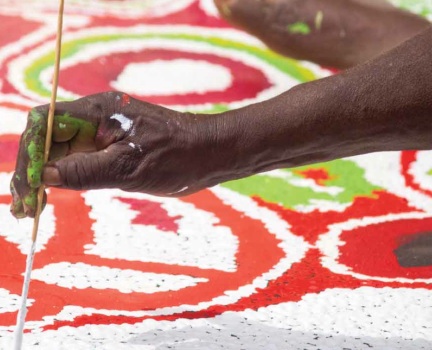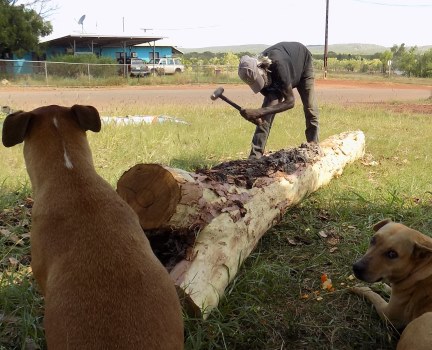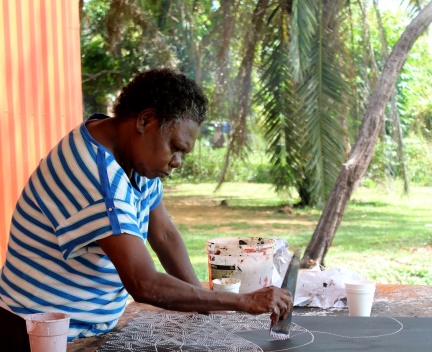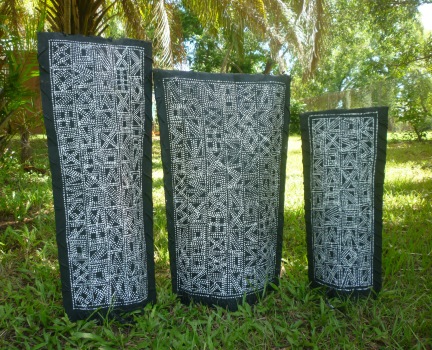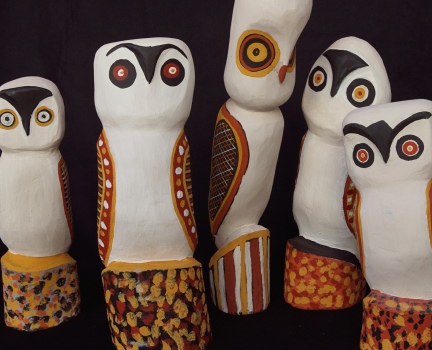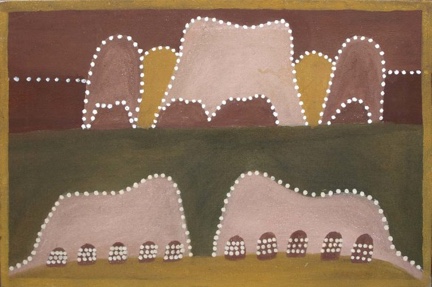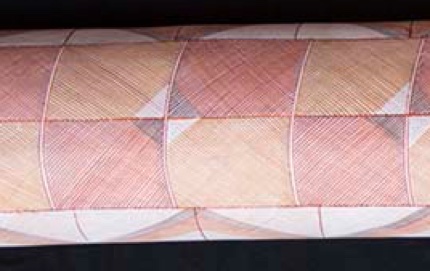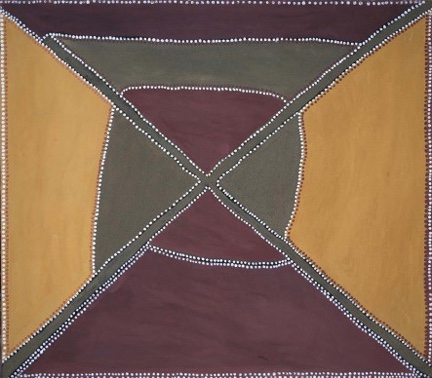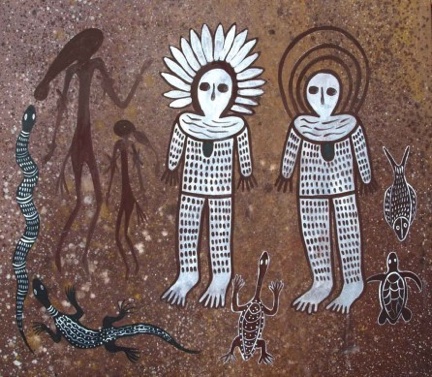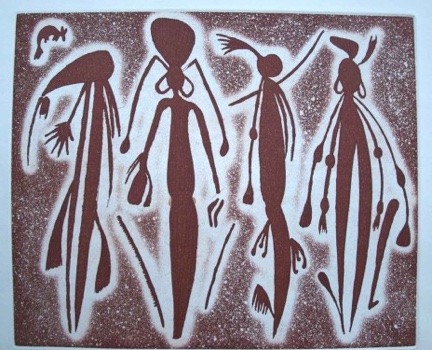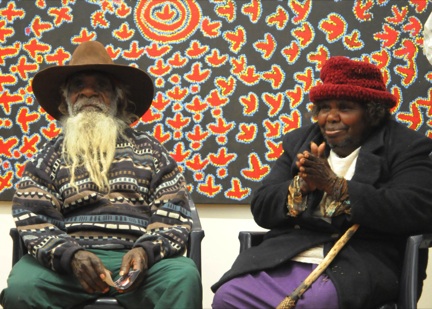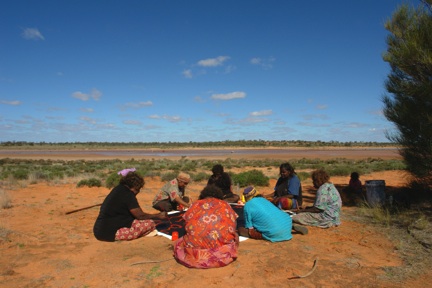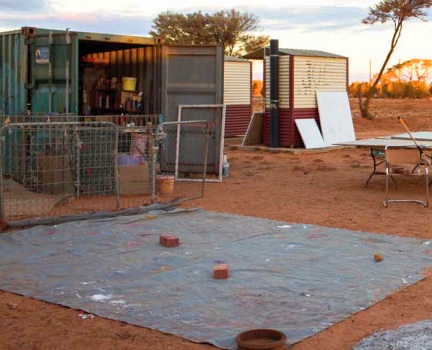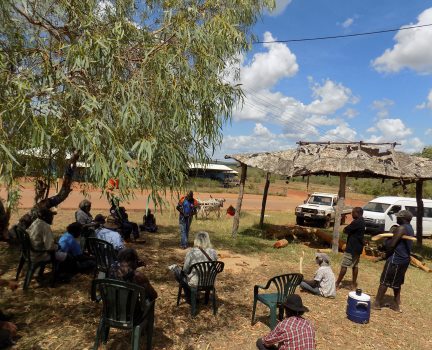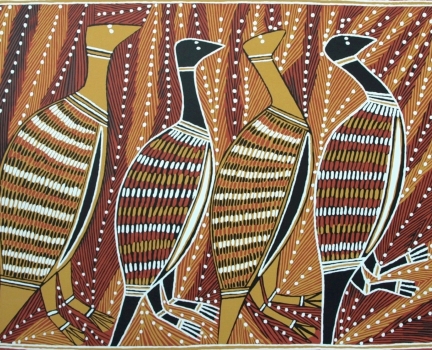Australian Aboriginal Art Centre Management


The Role of Aboriginal Art Centre Managers in Building An Art Business
Emilia Galatis is currently working with the Western Australian Art Gallery on the collaborative Kimberley arts project Desert, River, Sea. She has worked in several remote Aboriginal Art Centres helping to develop their art business. In this interview she discusses that work, the joys and the challenges.
Can you explain to people what a remote Art Centre is?
There are over ninety remote art centres in Australia. They all have a similar makeup, even though language groups and stylistic differences within those communities might change. They're Aboriginal owned organisations each with a Board of Directors. They might employ non-indigenous staff and local staff to run a commercial business within that remote community. That's predominantly through the sale of art, textiles and merchandise. They all have varying degrees or specialities within what they do.
What do you enjoy about your role, going into Art Centres and doing developmental work?
It's the best job in the world because you get to work with artists in a very hands-on and grassroots way. You also get to work in an organisation which is often bringing in non-welfare commerce into remote communities.
By being a good business manager and encouraging people to be better artists, you're changing the dynamic of remote communities. You are helping bring more national and international money into remote communities.
On top of that they're just the best artists in the world. They are confident, exciting, different and varied. After almost 50 years of the Australian indigenous art movement things keep getting stronger. They do all this while adjusting to cutbacks and funding problems and geographical isolation and the many terrible circumstances that go against how they operate. They've continued to be the strongest organisations in remote communities for decades.
What do you see in Art Centres that work well?
Art Centres work so well because they are more than just a place to make art. They assist economic independence. They give people a voice in wider society. They support social and mental well-being. They provide a place where people come together and make something that is commercially viable. It's also a safe place within these communities. That works well.
What do you see that could be done to get better outcomes in Art Centres?
More resources to train and empower extra staff would be very helpful. At the moment Art Centres do a lot for very little. Every year their job grows and gets bigger, and the demands are heavier. The market changes and to keep up to date with those things you need the time and space to be able to do that.
In an ideal future I would like to see more operational support for Art Centres and more local indigenous staff having the time to be trained properly to run the organisations.
You worked in Warakurna Art Centre for some years, what were the challenges there?
The Warakurna role was very challenging. The Centre worked across three remote art centres in the Ngaanyatjarra Lands, which is in remote Western Australia. It's close to the border with the Northern Territory. We supported three different communities that even within one language group had very different demographics and needs. We had commercial operations that crossed three communities and they were all different.
In one project we worked out of an Aged Care centre, with palliative care and dementia patients. Patjarr was a very tiny outpost, which was very remote and had no school and no clinic. We still had to operate a small workshop out of that space, which is one of the most incredible parts of the desert. Whereas Warakurna had a growing youth population and so we did a lot of things around streetwear and identity for younger people. It was a very diverse job. It was exciting.
You've worked in the Kimberley. Is that region different from the desert communities?
Yes absolutely, the Kimberley has a very different history compared to the desert, the Kimberley has a longer history of the cattle station movement and work and land rights. Some of the most powerful indigenous leaders in Australia have come out of the Kimberley. You know, June Oscar is the Human Rights Commissioner.
The Kimberley is interesting because the Arts Centre isn’t the only resource that people use. They might sell their work independently. They might have their own little commercial business. There’s a lot of other programmes, like Ranger programmes and culture programmes. The Arts Centre isn’t the only place that people can come together.
What are the qualities of a good Art Centre manager?
I don't think there is the ideal situation because as an Art Centre manager you might be curating a show for Germany and then liaising with the MCA (Museum of Contemporary Art Australia) and then unblocking a toilet. You need to be the kind of person who can do those things and can adapt and can think on your feet and can listen to your Board of Directors. A centre manager always has to remind themselves who you're working for and who they are working with. Your Board of Directors' wishes is part of your daily business. You also need to be strong and set firm boundaries.
A lot of people forget that their job is to run an art business in a remote community. It's not just about the bush trips even though they are a great part of the job. We're not only a cultural organisation. We are an art business.
What's the best way to induct new Art Centre managers coming into the job, do you think?
I think it'd be great to see peak bodies like universities have a robust vetted programme of interns that was funded. That way you could get more people out to communities to spend time, one week or two weeks before we started hiring. At least we could develop a pool of applicants based on internships, as opposed to hiring people you don't know and see if they're going to cut it.
How difficult is it to market art from a remote Art Centre?
It is difficult, it comes back to knowing that you're a business manager. Part of being a business manager is having clear business streams, like social media and marketing. You need to have a clear visual identity. If you are active in the online world with social media as well as your website, it isn't as difficult to access the world from your geographical isolation.
Often people have had time problems and they see that as a burden. But if you're doing that in an ongoing way and have clear visual messages, you will be able to market to a much broader audience.
If you can change anything, for an Art Centre future growth, what would you like to see happen?
As I've said I think more robust training and resources to get local staff to the level that can help run the organisation.
At the moment you can hire a new person, but if you can't train them because you're so busy, it defeats the purpose. And that's how most managers are now. It doesn't work in any organisation anywhere in the world. If you're just funded as one or two people, then you desperately need a third person, you find you don't even have the time to train them.
You've organised the Arts Hustle event over several years linking art galleries in Fremantle. Can you tell us about that?
Ten years ago I started a job at a commercial Indigenous Art gallery down the road from Japingka. Back then High Street was so quiet. I'd spend days alone in the gallery. I was in my early twenties and bored as hell. Then I started thinking, "Why aren't we having openings at the same time? Why aren't we encouraging more people, as a group of galleries to come to High Street?" So it just happened out of that. I came down and spoke to David and Ian, I spoke to a few other galleries, and most of them were keen.
I created an event that was more like speed dating for the arts. So it was quick presentations, four venues, they get a glass of wine and they get a snapshot of the arts in this area. There was the broader vision of attracting people to High Street and getting galleries to work collaboratively.
You did an internship as a curator in the States in 2016. Can you tell us about that? What came out of it for you?
I did an internship in Oakland at an organisation called Creative Growth. That was supported by the Western Australian State Government. I wanted to develop my skills and knowledge overseas and I had to broker the placement.
Creative Growth is a place I've been idolising for many years. It's an art centre that places work in galleries like the Guggenheim. It does international Art Fairs. It achieves a very high level of visibility as an arts organisation. It's a not-for-profit for disabled artists, predominantly within the Bay area of California.
What I learned from that is that when you're well resourced you can achieve a lot. This place had five different studios, so 170 artists a day worked there. They have a full-time nurse. They have five different studio spaces - ceramics, woodwork, textiles, sewing, painting. Then the artists never get sick of doing the same thing and their career is quite broad. They've also got a gallery space and a really great marketing scheme.
Everything I learnt there was mind-blowing. That art is all kinds of things. We work in a really exciting industry, but again it was like an Art Centre with 20 staff versus two. For the same amount of artists. It just comes down to the resources that you have that limit what can be achieved.
Are there any lessons that could be applied to the Aboriginal art market in Australia?
There is and there isn't. There is in terms of those artists being so wild and so brave. I think the US contemporary art market is more mature. They're not labelled as Indigenous artists or outsiders. They're just seen as part of the contemporary art stream.
We have equally good and exciting artists and great things happening here. The market is a bit more challenging here because of the box that Aboriginal art is always being placed in. There's a lot of pre-conceived notions that people have going in to purchase an art piece. It's Australia's only current successful art movement that's still going and changing and is exciting. I just think that we're getting there but galleries here need to be a bit braver and sell more.
You've joined the Art Gallery of WA team, at Desert, River, Sea project. Can you tell us about that?
The Desert, River, Sea is a really exciting project that the Art Gallery of Western Australia (AGWA) has been working on for six years with eight different regions in the Kimberley. I've been lucky enough to be brought onto it in its last year. The exhibition is on in a year's time. A publication will be produced as well. My role is liaising between the communities in the Kimberley and the State Gallery, to make sure that everyone's needs are met and that the exhibition reflects the artists' wishes as well as those of AGWA.
What are you looking forward to most with that project?
I am looking forward to working with artists again. I love being back out talking to people and being able to implement exactly the kinds of ideas that they have and want to see in that show. That's exciting.
It's all undocumented history. It's all things that only exist in art.
What attracted you to Aboriginal art?
I was really lucky that through a friend of my Mum's, I got offered a part-time job while I was at uni, working at a recently opened Merenda art gallery. At that stage I didn't know anything about Aboriginal art. I was selling it so I had to start teaching myself. The more I started teaching myself, the more fascinated I became. I felt this tremendous pressure to sell the work, because I had convinced people to give it to me to sell it. Everything I did drew me in more. I became more and more fascinated and because I turned out to be quite good at selling art, the Art Centres started asking me if I would do commercial events. I started being flown to different remote locations with the intention of selling art.
For example at the Martumuli Christmas Sale in Newman or the Art Fair in Darwin I was doing predominantly commercial work for remote art centres. There's never been a dull moment. I have never had to look for work. I've been lucky.
How do you see the future of Aboriginal art?
We need to start educating ourselves more. I think we're living in really exciting times in Australia. People are interested in learning about Indigenous art and culture. I think we're at a really interesting time. I think the best thing that people can do is start educating yourself.
Start knowing the difference between a dot painting and a landscape from the South West. Start looking at websites and familiarising yourself with what's out there. You'll undoubtedly learn more about a really exciting industry.
What advice do you have for people buying Aboriginal art?
Consumers need to educate themselves. If it's cheaper than the advertised price you've seen at a gallery, it's probably a counterfeit. Start educating yourself about where you're buying art as well. I think that's why people are scared of buying it because the messages are mixed and there's a lot online. If it's got good provenance and you're buying from a good gallery, you'll be fine.
Don't be afraid to ask questions. If you feel like you don't know enough to buy that piece of art ask yourself why, what more do you think you need to know. If you like the artwork and it's purchased from a good dealer, that's all you really need to know. There's always this myth that people need to know a deep level of story to purchase an artwork and feel comfortable liking it. If it's just great contemporary art and if you're actively reading about the provenance of where works come from, there's a multitude of great works out there.
Conversations with Aboriginal Art Centre Managers
Levi McLean
Art Centre Manager for Arlpwe Artists
2022 Article: A Day In The Life of Arlpwe Art & Culture Centre Manager
2022 Article: Off the Beaten Track: The Artists of Ali Curung
Katie Lynch
Visual Arts Manager for Barkly Regional Arts
2022 Article: New Energetic Works From Barkly Regional Arts Communities
2022 Article: Something Interesting Every Single Day
Will Heathcote
Studio and Workshops Coordinator at Jilamara Arts and Craft
2021 Article: Jilamara Arts and Craft From Strength to Strength
2021 Article: Tiwi Art Jilamara Exhibition Walk Through
Ingrid Johanson
Former Manager of Bábbarra Women’s Centre, Maningrida Arts Centre
2020 Article: Artists at Maningrida Art Centre
Dominic Kavanagh
Gallery Coordinator at Warmun Art Centre
2020 Article: Meet The Warmun Artists Featured in New Japingka Exhibition
2020 Article: Ochre Painting By Warmun Artists
Poppy Lever
Studio Coordinator for Warlayirti Artists
2019 Article: The Working Life of a Studio Manager at Warlayirti Artists
Cecilia Alfonso
Manager of Warlukurlangu Arts
2018 Article: The Joys and Challenge of Arts Management at Warlukurlangu Arts
Jane Menzies
Manager of Warakurna Artists
2018 Article: Warakurna Artists from The Place That Calls You Home
Caroline Hunter
Community Art Manager for the Artists of Ampilatwatja Aboriginal Corporation
2018 Article: From Berlin To Japingka – Ampilatwatja Artists Bring Their Joy
Patricia Floyd
Manager of Yinjaa-Barni Art
2017 Article: Art of the Yinjibarndi
Lucy Bond
Anindilyakwa Art and Culture Arts Coordinator
2017 Article: Bush Dyed Textiles From Anindilyakwa Art and Culture on Groote Island
Jude Emmett
Manager of the Ngukurr Arts Aboriginal Corporation
2016 Article: The Exciting Diversity Of Ngukurr Arts
Dianne Davies
Studio Co-ordinator for Tiwi Design Art Centre
2016 Article: Tiwi Design Art Centre: A Peaceful Place For Art
Leah Umbagai with Rosita Holmes
Art Development Co-ordinator for Mowanjum Art & Cultural Centre
2015 Article: Wandjinas, Ochre and The Art of Mowanjum People
Amanda Dent & Brian Hallett
Spinifex Arts Project Managers
2014 Article: Working With The Spinifex Arts Project
Art Centre Resources
The Desart Art Centre Guidebook
AACHWA
ANKA
Indigenous Art Centre Alliance
Related Exhibitions
- Artists of Ampilatwatja – Welcome to Paradise 2018
- Warakurna Artists – Welcome to Paradise 2018
- Spinifex Arts Project – 20th Anniversary 2017
- Yinjaa-Barni Artists 2017
- Artists from Ngukurr 2016
- Hamish Garrgarrku, Maningrida – Solo Exhibition 2015
- Cynthia Burke – Warakurna Artists 2015
- Mowanjum – Paintings & Prints 2015
- Marrga – Creating the Pilbara: Yinjaa-Barni Artists
- Tiwi Carvings & Sculptures 2014
- Heart Lands – Iwantja Artists 2014
- Ampilatwatja Artists 2013
- Yinjaa-Barni Artists Paintings 2013
- Iwantja Artists 2013
- Ampilatwatja Artists 2012
- The Pilbara – Yinjaa-Barni Artists 2012
- Mowanjum Artists – Paintings and Prints 2011
- Spinifex Artists Exhibition 2011
- Yinjaa-Barni – Pilbara Artworks 2011
- Aurukun Artists 2011
Artworks & Articles
Ampilatwatja Art Centre
Anindilyakwa Art
Barkly Arts
Ikuntji Artists
Mangkaja Arts
Maningrida Arts
Many Hands Art Centre
Mowanjum Art Centre
Munapi Arts Centre
Ngukurr Arts
Spinifex Arts Project
Tiwi Designs
Warakurna Artists
Warlukurlangu Artists
Yinjaa-Barni Art
